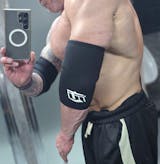
Learn why weight lifting belts are a game-changer for safety, performance and progress. Discover expert tips and top picks at Team Industry.
The MVP of Heavy Lifting: Why You Need a Belt
This dependable hero of strength training makes it easier to stay injury-free and can be your partner in personal bests. Every lifter needs a weight lifting belt and to know how to intelligently make the most of it.
Why Weight Lifting Belts are a Reliable Boost
1. Amplified Core Stability
Think of a Weight Lifting belt as an external core booster. By creating intra-abdominal pressure (IAP), it stabilises your spine, letting you control heavier weights without sacrificing form. More stability = bigger lifts.
2. Back-Up for Your Back
Heavy deadlifts and squats test your lower back like nothing else. A good weight training belt supports your lumbar region, acting as a shield against strain and reducing the risk of injury.
3. Boosted Performance
Many lifters report an instant increase in strength and control with a belt. Why? It minimises energy leaks, allowing you to channel every ounce of effort into the lift.
4. Confidence Under Pressure
There’s a psychological edge, too. Knowing your core and back are locked in lets you push boundaries safely and push through mental barriers.
When to Buckle Up
Not all lifts call for a weight lifting belt, but it’s a must for these powerhouse exercises:
● Deadlifts: Especially when pulling near your 1-rep max.
● Squats: Whether back or front, heavy squats benefit from that added support.
● Overhead Presses: Stabilise your core when Weight Lifting above your head.
How to Choose the Perfect Weight Lifting Belt
Not all belts are created equal, and picking the right one can make all the difference. Here’s what to look for:
Thickness for Balance
A 10mm-thick belt is a popular choice, striking the perfect balance for most lifters. It provides enough rigidity for maximal support while remaining flexible enough for dynamic movements. For advanced lifters focusing on powerlifting, a thicker 13mm belt might be a better fit, delivering extra rigidity for heavy squats and deadlifts.
Material Matters
The foundation of a great lifting belt lies in its material. High-quality leather belts provide long lasting durability and consistent support.
Team Industry’s Top Pick: The Leather Weight Weight Lifting Belt
Our standout recommendation is the collection of Leather Weight Lifting Belts from Team Industry. Built to last and designed with lifters in mind, it offers:
● Superior lumbar support.
● Adjustable sizing for a custom fit.
● Comfort that won’t dig into your sides, no matter how heavy you go.
Pro Tips for Maximum Belt Benefits
- Wear It Right: Position the belt just above your hip bones. Tighten it enough to create pressure, but not so much that breathing feels impossible.
-
Save It for the Big Lifts: Use your belt strategically—reserve it for heavy compound lifts, not every set.
- Show It Some Love: Clean your belt regularly and store it in a dry spot to keep it in peak condition.
Push Your Training Further
A belt isn’t just about lifting heavier, it’s about lifting smarter. It’s about safety, confidence, and setting new personal records.
Your next PR is calling. Answer it with confidence.
FAQ: Everything You Need to Know About Weight Lifting Belts
Q: Should beginners use a weight lifting belt?
A: Yes, but only for heavy compound lifts. Beginners should focus on mastering proper form and core engagement first.
Q: How tight should a weight lifting belt be?
A: It should feel snug but not restrictive. You should still be able to breathe deeply and brace effectively.
Q: Can weight lifting belts prevent all injuries?
A: No, but they significantly reduce the risk when used alongside proper technique and gradual progression.




